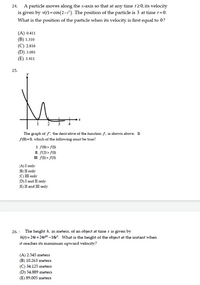Question
Please do all three part of these question. Thank you for your help.

Transcribed Image Text:24. A particle moves along the x-axis so that at any time 120, its velocity
is given by v(r) = cos(2-r²). The position of the particle is 3 at time t=0.
What is the position of the particle when its velocity is first equal to 0?
(A) 0.411
(B) 1.310
(C) 2.816
(D) 3.091
(E) 3.411
25.
The graph of f. the derivative of the function f. is shown above. If
F(0)=0, which of the following must be true?
1 f(0) > f)
II f(2) > S)
m f(1)> f(3)
(A) I only
(B) II only
(C) I only
D) I and II only
(E) II and III only
26. The height h, in meters, of an object at time t is given by
h(1) = 24t +24: –16r?. What is the height of the object at the instant when
it reaches its maximum upward velocity?
(A) 2.545 meters
(B) 10.263 meters
(C) 34.125 meters
(D) 54.889 meters
(E) 89.005 meters
Expert Solution
This question has been solved!
Explore an expertly crafted, step-by-step solution for a thorough understanding of key concepts.
This is a popular solution
Trending nowThis is a popular solution!
Step by stepSolved in 2 steps

Knowledge Booster
Similar questions
- Please read the question and leave notes on the answer where appropriate. Please DO NOT skip any steps. Please double check your answer.arrow_forwardNeed help on this question.arrow_forwardCan someone please help me with these questions below? I appreciate the help! Thank you in advanced.arrow_forward
arrow_back_ios
SEE MORE QUESTIONS
arrow_forward_ios